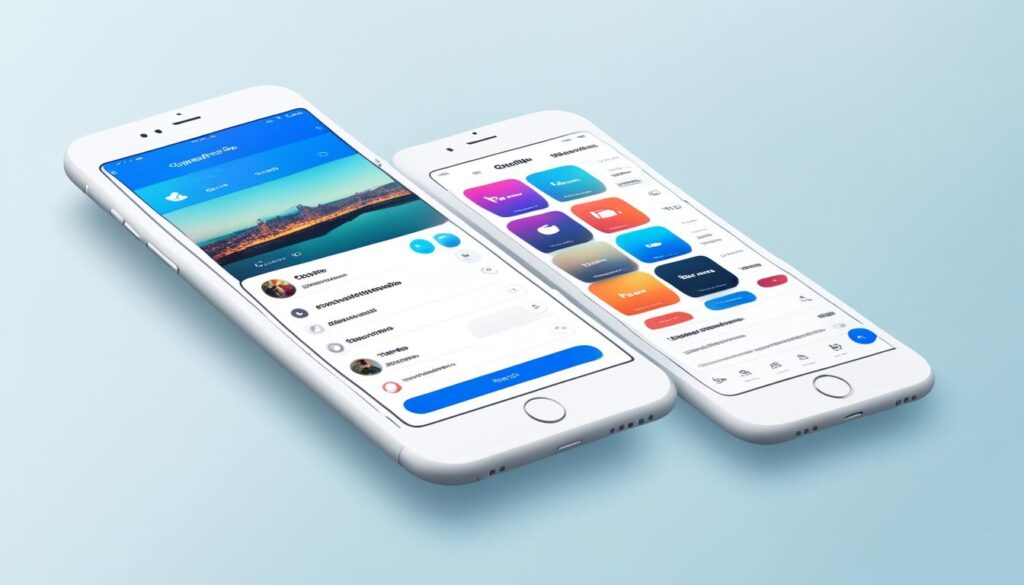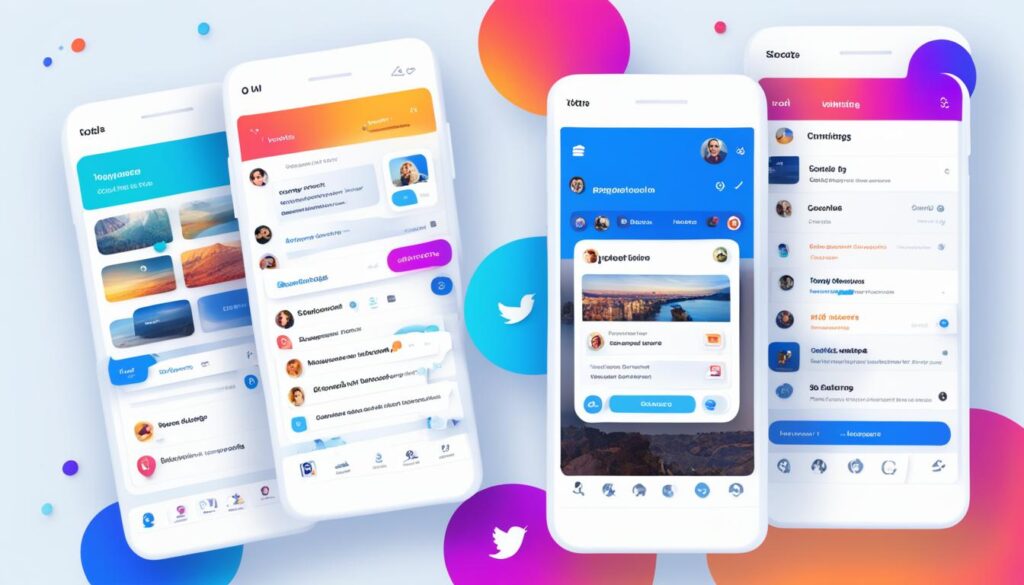Social media has taken over our digital world. Facebook leads the pack, showing what a top social media app should be like. If you want to make a social media app as big as Facebook, this guide will show you how.
Creating a social media app is now a big goal for many. Entrepreneurs and businesses see the huge chance to build a strong online community. You might want to make a Facebook-like app or something new. Knowing what makes the big names work is key to your success.
This article will look into the world of social media. We’ll talk about what makes a social media app successful. We’ll also guide you through planning, designing, and launching your app to grab your audience’s attention.
Table of Contents
Key Takeaways
- Understand the current social media landscape and the key features that define successful social media apps.
- Strategically plan your social media app by defining your target audience and their needs.
- Design an engaging user experience with a user-friendly interface and intuitive navigation.
- Implement core features like user registration, content sharing, real-time messaging, and more to create a thriving social network.
- Explore monetization strategies, including advertising and in-app purchases, to ensure the long-term sustainability of your social media app.
Understanding the Social Media Landscape
The social media world has changed a lot in the last ten years. It has grown fast and changed a lot. Now, social networking is a big part of our lives. Knowing about the trends and what makes popular social media apps work is key for making your own app like Facebook.
The Rise of Social Media Platforms
Many social media platforms have come up, each with its own style and features. Big names like Facebook and Instagram are popular, and new ones focus on special interests or groups. This shows how the social media industry trends have changed a lot. Looking at how these platforms grew can teach us about what users want.
Key Features of Successful Social Media Apps
- Intuitive and user-friendly interface design
- Engaging content feed and seamless navigation
- Robust content sharing and interaction capabilities
- Personalized user profiles and customization options
- Real-time messaging and instant communication features
- Effective integration of popular social media app features and social networking app development best practices
Knowing about the social media world and what makes apps successful can help you make your app better. This way, you can grow your app and keep users interested.
“Social media has become the most powerful tool of the 21st century, connecting people, ideas, and communities like never before.”
Planning Your Social Media App
Planning is key to making a social media app successful. Knowing who your audience is and creating user personas is vital. Through deep social media app market research, you learn about your potential users’ needs and likes. This helps you make an app that speaks to them.
Defining Your Target Audience
Start by figuring out who your social media app is for. Target audience analysis means looking at who you want to reach. You’ll learn about their age, interests, and what they need. This helps shape your app’s features and design.
Think about your users’ age, gender, where they live, what they like, and what bothers them online. This info helps you make a user persona. It’s a detailed picture of your ideal user. This guides your app’s design and what it does.
| User Persona Attributes | Example |
|---|---|
| Demographic | Millennial, female, urban resident |
| Psychographic | Socially conscious, environmentally aware, tech-savvy |
| Behavioral | Frequent social media user, engages with brands that align with her values |
| Pain Points | Feels overwhelmed by the amount of content on existing social media platforms, desires a more curated and meaningful experience |
Knowing your audience and making detailed user personas helps you make your social media app just for them. This way, you’re more likely to succeed in the social media app market.
Designing an Engaging User Experience
Making a social media app exciting is key to its success. At the core is social media app UI/UX design. This is about making an interface that looks good and is easy to use. It makes users want to spend more time on your platform.
User-Friendly Interface Design
A great user interface (UI) is crucial for a social media app. It should be clean, simple, and eye-catching. Using the right colors, fonts, and images makes the app look unified and interesting.
Intuitive Navigation and Feed
Navigation in social media apps is also vital. It should be easy for users to find what they need. A well-designed content feed keeps users interested by showing them relevant and engaging content.
Putting the user first helps make a social media app not just look good but also get users to stick around. Finding the right mix of looks and function is what makes an app a favorite among users.
“Great design is not just about how something looks, but how it works.”
| Design Element | Best Practices |
|---|---|
| Color Scheme | Use a cohesive and visually appealing color palette that aligns with your brand identity. |
| Typography | Select clean, legible fonts that enhance readability and create a polished look. |
| Navigation | Implement a intuitive, user-friendly navigation structure with easy access to key features. |
| Content Feed | Optimize the feed to deliver a curated, engaging stream of content to keep users engaged. |
Core Features to Include in Your App
Creating a hit social media app means picking key features that meet user needs and build a strong community. Starting your social network app development, focus on adding features that are similar to what Facebook users love.
To stand out in the social media world, think about adding these core features:
- User Registration and Authentication – Offer safe sign-up and login options. This lets users create their own accounts and profiles.
- Content Sharing and Engagement – Let users share texts, photos, and videos. They can also comment, like, and share posts.
- Real-Time Messaging and Notifications – Make messaging instant and keep users updated with push notifications about their social network activity.
- Friend Requests and Connections – Let users grow their social circle by sending and accepting friend requests, building a community feeling.
- Profile Creation and Customization – Give users the power to make their profiles their own, including info, photos, and interests, which helps them express themselves.
With these key social media app features, you can make your app feel familiar and easy to use, like Facebook. This will help keep users coming back to your social network app.
“To build a successful social media app, it’s crucial to focus on the core features that users expect and value most.”
User Registration and Authentication
Creating a secure and easy sign-up and login process is key for your social media app’s success. By focusing on social media app user onboarding and secure authentication methods, you gain your users’ trust. This ensures their user data privacy is safe.
Secure Sign-Up and Login Options
Give your users different ways to sign up and log in. Think about adding these secure ways to log in:
- Email and password registration
- Social media account integration (e.g., Facebook, Google, Twitter)
- Two-factor authentication (2FA) for extra security
- Biometric authentication, like fingerprint or facial recognition
With these secure sign-up and login choices, you make sure the social media app user onboarding is smooth. At the same time, you keep their user data privacy top-notch.
“Prioritizing user security and trust is essential for the long-term success of any social media app.”
A secure and easy-to-use login process is the base for a loyal user base. It also helps protect user data privacy in your social media app.
How to Create a Social Media App Like Facebook
To make a social media app like Facebook, you need to know the social media app development process. You also need to understand Facebook-inspired app architecture and social network app programming. With a good plan, you can make a platform that grabs users’ attention and shines in the crowded social media world.
Choosing the right technology stack is a crucial step. This means picking the best programming languages, frameworks, and databases for your app. You also need to design the app’s architecture for scalability, security, and a smooth user experience.
- Define the core features and functionalities of your social media app, such as user profiles, news feeds, messaging, and content sharing.
- Implement user authentication and authorization mechanisms to ensure secure sign-ups and logins.
- Develop a responsive and visually appealing user interface that aligns with the overall branding and design of your social media app.
- Integrate real-time communication features, such as instant messaging and notifications, to foster user engagement and interactivity.
- Incorporate data analytics and performance monitoring tools to track user behavior, measure engagement metrics, and optimize the app’s performance.
By carefully planning and executing the social media app development process, you can make a platform that stands out. It will offer a user experience as smooth as Facebook’s.
“The key to building a successful social media app is understanding the needs and preferences of your target audience, and then designing an app that caters to those needs.”
The Facebook-inspired app architecture and social network app programming are just the start. The real success of your social media app will come from creating a unique and engaging user experience. This will keep your audience coming back.
Profile Creation and Customization
In the world of social media, profiles are like digital avatars for people. Making a profile that stands out is key to doing well on social media apps. By letting users create and customize their profiles, you help them feel like they belong and care more about the platform.
Personal Information and Profile Picture
Letting users share their name, bio, and where they’re from lets them show who they are online. Uploading a profile picture lets them show off their look, making their connection to the app stronger.
Options like changing profile colors, backgrounds, and layouts let users make their space their own. This kind of user identity management makes people more likely to engage with the platform. They feel more connected and want to be part of the social media scene.
| Profile Customization Feature | Benefit |
|---|---|
| Personal Information | Allows users to express their unique identity |
| Profile Picture | Enables visual representation of the user |
| Customizable Colors and Layouts | Fosters a sense of ownership and personalization |
By focusing on social media app user profiles and profile customization options, you make a platform that speaks to your audience. This leads to more user engagement and keeps people coming back.
Content Sharing and Engagement
At the core of social media apps is the ability for users to share engaging content. Whether it’s a text post, a photo, or a video, making it easy to create and share is key. This helps build a lively online community.
Text, Photo, and Video Posting
Give your users easy tools to make and post text, photos, and videos. Letting them express themselves in different ways boosts participation and engagement.
Commenting, Liking, and Sharing
Add tools that let users comment, like, and share posts. These features encourage deep interactions and spread user content far and wide. This is crucial for your app’s growth.
Focus on sharing and engaging in your social media app. This makes your platform connect with users, build community, and keep users coming back.
| Feature | Description | Benefits |
|---|---|---|
| Text, Photo, and Video Posting | Intuitive tools for users to create and share text-based posts, images, and videos. | Encourages active user participation and diverse content expression. |
| Commenting, Liking, and Sharing | Engagement features that allow users to interact with content through comments, likes, and sharing. | Fosters meaningful interactions and amplifies the reach of user-generated content. |
“Enabling users to effortlessly create and share content is the foundation of a successful social media app. It’s the key to building an engaged, vibrant community.”
Building a Social Network
At the core of a hit social media app is making strong connections between users. The social graph is like a map of all the relationships and interactions on the platform. It’s key to building these connections. With great user networking features and a smart friend and follower system, users can find, connect, and talk with each other easily. This makes a social network grow and thrive.
Friend Requests and Connections
Sending and getting friend requests is a key part of social media apps. It lets people build their networks with friends, family, and others who share their interests. Making it easy to send, accept, and manage these requests is important. It helps build a strong community and keeps users coming back.
Apps also have a follower system for users to follow others’ content without needing to be friends. This way, users can see more content and grow their network. It makes the social media app’s social graph stronger.
By making it easy for users to build and keep their networks, you can grow a lively and active community. This keeps users coming back and makes your social media app more engaging.
Real-Time Messaging and Notifications
In today’s fast world, staying connected is key. That’s why social media app messaging, in-app notifications, and real-time communication features are vital. They help keep users in the loop and make social media more engaging.
Instant messaging lets users talk in real-time. It’s great for one-on-one chats or group talks. This feature builds a strong community feeling and keeps users coming back.
Push notifications send updates and alerts right to users’ screens. They make sure no one misses out on important news or events. This keeps users connected to their friends and interests.
- Implement robust social media app messaging functionality to facilitate real-time conversations
- Leverage in-app notifications to keep users informed and engaged with the latest updates and activities
- Enhance the overall user experience by incorporating real-time communication features that foster a sense of community and connectedness
By adding these features, your social media app will be more appealing. It will keep users coming back and feeling connected.
Integrating Advertising and Monetization Strategies
Building a social media app means creating a strong business plan for success. It’s important to mix effective ads and ways to make money that don’t upset users. Using targeted ads and in-app purchases or subscriptions can make your app both fun and profitable.
Targeted Advertising Options
Adding targeted ads to your app can boost your earnings. By using user data, you can show ads that really speak to your audience. This makes ads more enjoyable for users and more effective for you, leading to more clicks and better money-making.
In-App Purchases and Subscriptions
Along with ads, in-app purchases and subscriptions can help make money. People might pay for special features, extra content, or tools that make their app use better. If you design these options well, everyone wins. Users get what they want, and you make a steady income.
| Monetization Strategy | Advantages | Disadvantages |
|---|---|---|
| Targeted Advertising |
|
|
| In-App Purchases and Subscriptions |
|
|
By thoughtfully combining these social media app monetization strategies, you can build a strong money-making plan. This plan supports your app’s growth and gives users a great targeted advertising and in-app revenue streams experience.
Testing, Deployment, and Maintenance
Creating a successful social media app is just the start. To keep it going strong, focus on thorough testing, effective deployment, and ongoing maintenance. A strong quality assurance process and a detailed maintenance plan help you deliver a top-notch app. This app will meet your users’ changing needs and expectations.
Ensuring App Performance and Security
Before you launch, extensive testing is key to find and fix any problems. This includes testing your social media app to check user flow, functionality, and performance. Also, make sure to focus on app security. Use strong authentication, encrypt data, and update security regularly.
When it’s time to deploy your app, deployment best practices are vital. Plan your rollout carefully, make sure new users can easily start using the app, and watch how the app performs at first.
To keep your app successful over time, have a strong app maintenance and updates plan. Regularly listen to user feedback, add new features, and improve the app’s performance. This keeps your app fresh and interesting for your users.
| Key Considerations | Best Practices |
|---|---|
| Social Media App Testing |
|
| Deployment |
|
| Maintenance and Updates |
|
Focus on social media app testing, deployment best practices, and app maintenance and updates. This ensures your app’s long-term success and gives your users a smooth, engaging experience.
“The true measure of a social media app’s success is its ability to adapt and evolve alongside the changing needs and preferences of its users.”
Conclusion
In this guide, we’ve covered the key steps to make a social media app as popular as Facebook. We looked at the changing social media scene, finding out who your audience is, and making the app engaging. This gives you a solid base to build a successful social network.
Important points from this article are about adding features like user sign-up, custom profiles, sharing content, messaging in real-time, and making money. Also, testing well, deploying safely, and keeping the app up-to-date are vital for its success and lasting value.
Starting your social media app journey, keep your audience’s changing needs in mind. Always listen to what users say, watch how they interact, and update your app to stay competitive. With the advice in this article, you’re ready to move forward and build a social network that draws in and keeps users interested.













